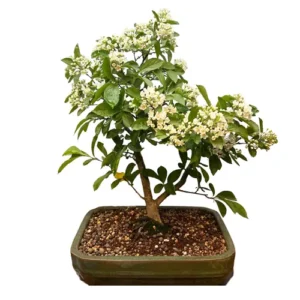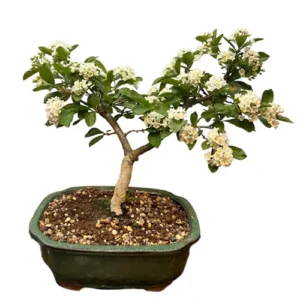Myrciaria cauliflora
Jabuticaba Bonsai
Native to South America. Also known as the Brazilian Grape Tree, this evergreen species can grow to 50 feet tall and 100 years old in nature. As a bonsai, Jabuticaba make bewitching bonsai and can be trained in many styles.
Jabuticaba Bonsai Care Tips
Placement
For your Jabuticaba to flower, full sun and warmth are necessary. In a temperate climate like the UK, it is important to know temperatures below 10 degrees C will slow growth and demand the plant needs protection. In more temperate regions, you can over winter a Jabuticaba indoors with grow lights.
Watering
Across the growing season, Jabuticaba demands a lot of water and will grow vigorously. The rootball should be kept moist throughout the summer. Be careful to avoid overwatering as this can bring on root rot. During winter, let the surface soil dry before watering. This species responds well to high humidity.
Feeding & Fertilising
Across the growing season, feed your Jabuticaba once a month with a phosphorus-rich fertiliser. A liquid feed can be used weekly during the growing season as an alternative.
Pruning & Wiring
Pruning your bonsai is important not only to create or maintain an aesthetic style but to also ensure optimal health. Maintain the shape of your Jabuticaba by trimming shoots and twigs several times across the year, but not in winter. Only robust, hard pruning should be done by winter’s end.
Wire Jabuticaba delicately as the bark is incredibly smooth and will scare easily. We recommend using wires with a thickness that matches the thickness of the branch: if the wire you choose is too thick you will damage the bark. If it is too thin, it won’t be effective.
Repotting
Repotting your tree is an important way to provide a fresh and suitable soil mix and ensure appropriate root health. Every two years in Spring, repot your Jabuticaba when its growth begins. Find a soil mix that keeps moisture as well as drains well.
Trees that are ready for repotting will require root pruning, a suitable new pot and appropriate soil mix.
When repotting, do not cut back the root mass by a large amount, and choose a well-draining soil mix that has a neutral or slightly higher PH value of 5-6 but not over 7. We tend to use a mixture of different speciality bonsai soils on our trees. Every species is different so please contact us for free soil-mix advice or to take advantage of our repotting service.
Bonsai make for a one-of-a-kind indoor plant offering elegance, nature and art all in one minute form. Across an array of exquisite and erudite species, they all demand their own specific care and cultivation needs in order for their beauty to flourish. We have an extensive library of care guides for indoor bonsai trees so you can make an informed and considered choice. It’s not about selecting the perfect bonsai, it’s about selecting the perfect bonsai for you.
Jabuticaba Bonsai - Typical Queries
How to propagate Jabuticaba bonsai?
Jabuticaba are best propagated with either seeds or air-layering. Seed sowing will take a long time to see its results. Air layering in the winter from a branch currently bearing fruit is the most popular choice.
Do Jabuticaba bonsai attract pests and diseases?
Jabuticaba bonsai can fall prey to pests. Scale, aphids and nematodes can cause these species problems. Altering the plants’ growing conditions and applying the right insecticide can address this. Canker, dieback and fruit rot can also occur for this bonsai. Appropriate fungicide is necessary in this circumstance.
Can you keep a Jabuticaba bonsai outdoors?
As a tropical species, the Jabuticaba is best kept outdoors in environments that provide its ideal temperature range of 18-29 degrees C. Humidity is also a considerable factor in the healthy growth of this plant. In the UK or other such temperate climates, this is a species best grown indoors and given the appropriate artificial growing conditions to support its health.





















